Creative midfielders are the artists of the beautiful game and therefore, are very in demand from scouts if they go to watch tournaments like the U21 championship. These players possess a unique blend of vision, technique, and intelligence, which allows them to orchestrate the team’s attacking movements and unlock stubborn defences with their creativity.
They are the catalysts of the team’s offensive play, acting as the link between the midfield and the forward line. These players are responsible for dictating the tempo of the game, threading precise through balls, and providing key assists that lead to goals. Their ability to read the game, make quick decisions, and execute pinpoint passes makes them indispensable to any team aspiring to play an attacking brand of football.
Creative central midfielders have an innate ability to control the flow of the game. They possess exceptional ball control, close dribbling skills, and an astute awareness of their surroundings. Their mastery of space allows them to find pockets of gaps in the opposition’s defence, creating opportunities for their teammates to exploit.
These players not only contribute to the offensive aspect of the game but also play a crucial role defensively. They are involved in pressing the opposition, intercepting passes, and regaining possession. Their positional awareness and tactical understanding allow them to disrupt the opponent’s build-up play and provide defensive cover for their teammates.
However, the main focus for players of this type is on attacking actions and chance creation. Their ability to control the game, unlock defences, and influence the outcome of matches through their ingenuity and skill make them indispensable assets for any team aspiring to achieve success on the football pitch.
Methodology
In the data analysis, we take a look at the key metrics that can evaluate how much influence a creative midfielder has had in a game. We use metrics that measure ball progression, attacking threat and attacking output.
In preparing the graphs, we used a filter that excludes players who have not played in the qualification phase. This is because players who’ve had limited or no minutes in the qualification matches have a small sample size of data, which means the numbers can be skewed. Additionally, we only filtered players that are currently below 22 years of age. Midfielders that played in the qualification phase but are older than 21 now, are not part of this analysis.
Ball Progression
The best creative midfielders have the ability to progress the ball through the thirds. Having a player like this is vital for any team to be able to create chances. We measure who the best ball-progressing central midfielders are, by looking at the number of progressive runs they make per 90 minutes, alongside how many progressive passes they average.
In this case, as defined by Wyscout, a pass is considered progressive if the distance between the starting point and the next touch is:
- At least 30 metres closer to the opponent’s goal, if the starting and finishing points are within a team’s own half,
- At least 15 metres closer to the opponent’s goal, if the starting and finishing points are in different halves,
- At least 10 metres closer to the opponent’s goal, if the starting and finishing points are in the opponent’s half.
The same applies for a run to be considered progressive, but the starting point is the player’s first touch, and the finishing point is his last touch.
The U21 championship will showcase some exceptional central midfielders who excel in terms of ball progression, contributing significantly to their teams’ attacking play.
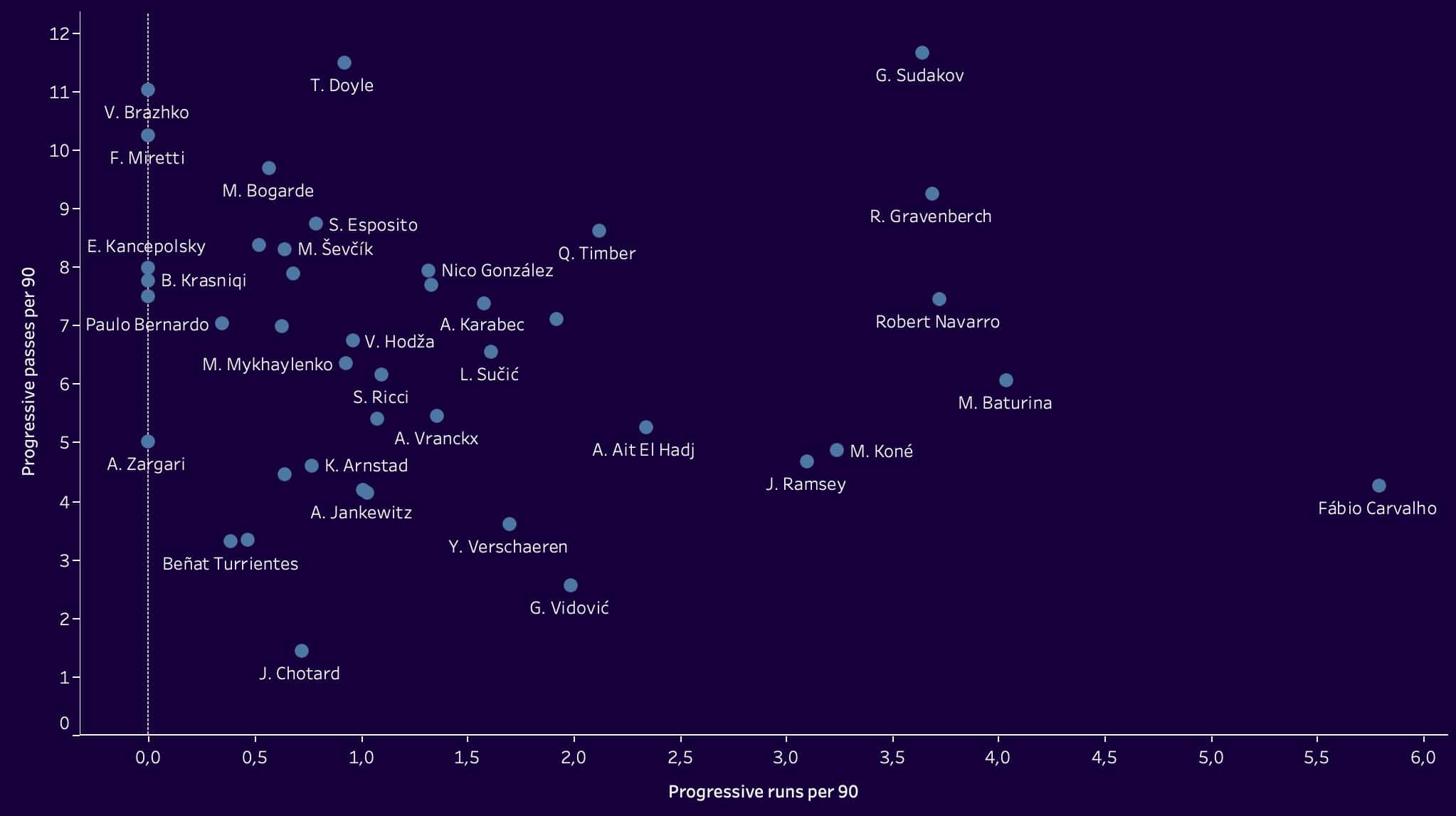
In terms of average progressive passes per 90, the following midfielders demonstrated remarkable vision and passing ability. Topping the list is Georgiy Sudakov from Ukraine, who averaged an impressive 11.65 progressive passes per 90. His ability to pick out forward passes that advanced the team’s attacking play was exceptional. Tommy Doyle from England closely followed with an average of 11.48 progressive passes per 90, displaying his ability to consistently drive the ball forward with precision. Volodymyr Brazhko, also from Ukraine, showcased his passing prowess with an average of 11.02 progressive passes per 90.
Moving on to progressive runs per 90, it is evident that certain midfielders had a knack for carrying the ball forward and creating opportunities through their dribbling skills. Fabio Carvalho from Portugal topped the list with an impressive average of 5.79 progressive runs per 90, highlighting his ability to penetrate opposition defences with his direct running. Martin Baturina from Croatia displayed his attacking intent with an average of 4.04 progressive runs per 90, while Robert Navarro from Spain demonstrated his dribbling prowess with an average of 3.72 progressive runs per 90.
When considering both progressive passes and runs, a few standout players combined their passing ability with effective dribbling to maximize their impact on ball progression. Georgiy Sudakov from Ukraine continued to shine as he topped the list in this category as well, displaying his versatility and influence in driving the team forward. Ryan Gravenberch from the Netherlands showcased his ability to contribute in both passing and running aspects, while Robert Navarro from Spain demonstrated his well-rounded skill set.
Dribbles
Dribbling is a fundamental skill in football that involves a player carrying the ball past opponents while maintaining control and possession. It is a key element of individual creativity and can be a game-changing skill when executed effectively. The success rate of dribbles, as specified by Wyscout, is an important metric that measures the effectiveness and efficiency of players in taking on opponents.
The success rate of dribbles refers to the percentage of successful dribbles out of the total attempted. It provides valuable insights into a player’s ability to navigate through tight spaces, beat defenders, and create opportunities for themselves and their teammates. A high success rate indicates proficiency in dribbling, showcasing a player’s agility, close control, and decision-making on the pitch.
The importance of the dribble success rate lies in its impact on the dynamics of the game. Successful dribbles can break through defensive lines, destabilize opponents’ formations, and create openings in compact defences. They can be instrumental in bypassing pressing strategies, unlocking stubborn defences, and initiating attacking plays. Dribbles can create numerical advantages, force opponents into committing fouls, and generate scoring opportunities.
The U21 championship will feature an array of talented central midfielders who showcase exceptional dribbling skills, demonstrating their ability to beat opponents and create opportunities for their teams. Let’s delve into the standout performers in terms of dribbling during the tournament.
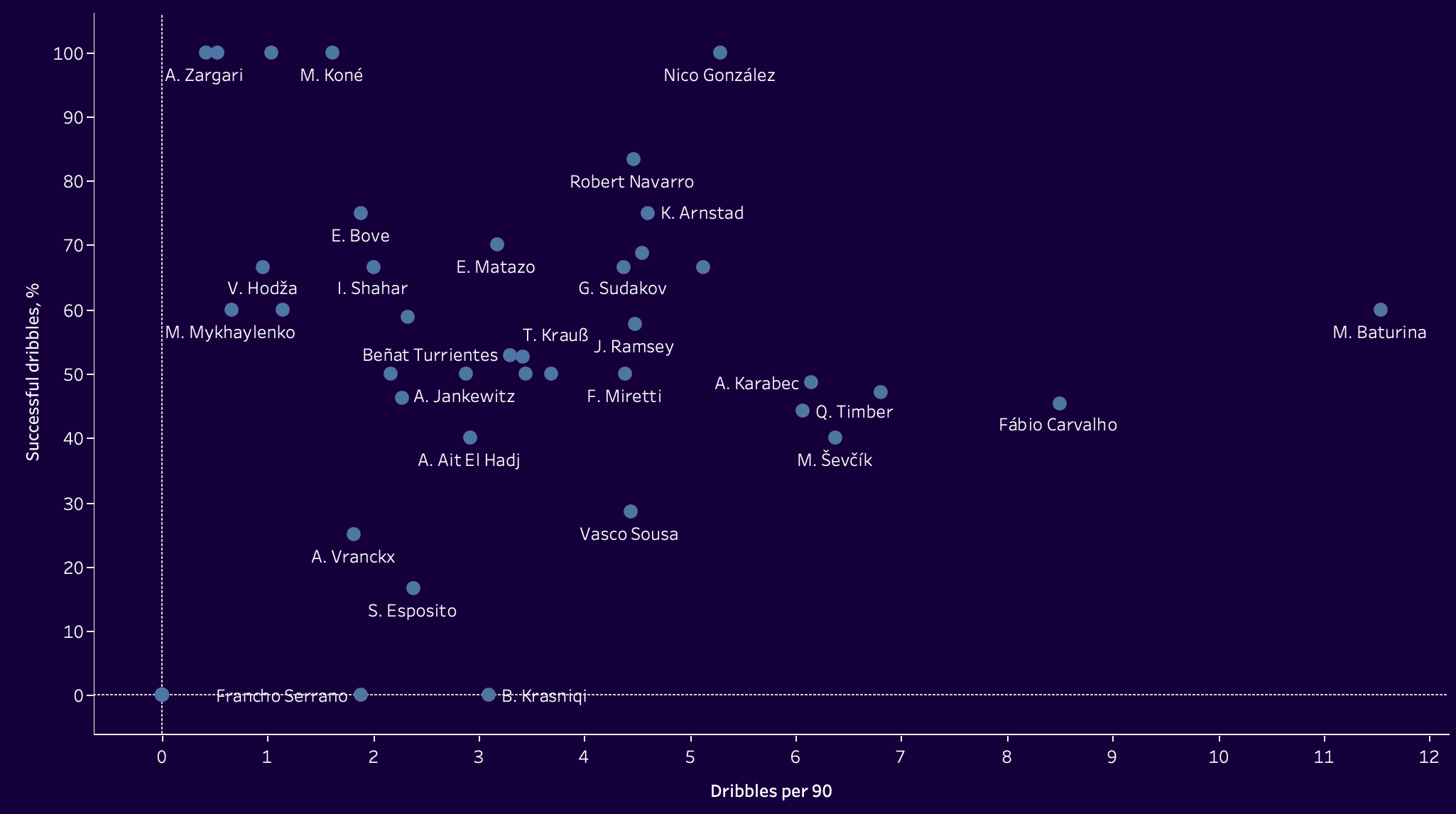
Leading the way in terms of the number of dribbles per 90 is Martin Baturina from Croatia, with an impressive average of 11.54 dribbles per 90. His ability to take on opponents with confidence and execute successful dribbles consistently made him a potent threat in the attacking third. Fabio Carvalho from Portugal closely follows with an average of 8.50 dribbles per 90, showcasing his agility and skill on the ball. Quinten Timber from the Netherlands also exhibited his dribbling prowess, averaging 6.07 dribbles per 90.
Moving on to the dribble success rate, several midfielders displayed remarkable efficiency in their dribbling attempts. Nico Gonzalez from Spain, Manu Koné from France, Sivert Mannsverk from Norway, Erik Martel from Germany, and Aviel Zargary from Israel all achieved a perfect 100% success rate in their dribbles. Their ability to maintain control of the ball while manoeuvring past opponents reflects their exceptional technical ability and composure in tight situations.
When considering both the number of successful dribbles and the highest success rate, a few standout players showcased their dribbling skills while maintaining an impressive success rate. Nico González from Spain, who also topped the dribble success rate category, demonstrated his ability to beat opponents consistently while retaining possession. Robert Navarro from Spain displayed his technical ability and agility on the ball, while Kristian Arnstad from Norway showcased his dribbling prowess and efficiency.
Final Third Impact
Passes into the final third in football are a critical aspect of the game that involves delivering accurate and well-executed passes from the middle or defensive zones of the pitch into the attacking third. These passes play a crucial role in breaking through defensive lines, creating goal-scoring opportunities, and initiating attacking plays.
According to Wyscout’s definitions, a pass into the final third refers to a successful forward pass that crosses the dividing line between the middle third and the attacking third of the pitch. These passes are aimed at bypassing opponents and reaching teammates positioned in more advanced areas of the field, closer to the opposition’s goal.
The importance of successful passes into the final third lies in their ability to break down compact defences, penetrate defensive lines, and create opportunities for goal-scoring. By successfully delivering passes into advanced areas, teams can gain a numerical advantage in attacking situations, disrupt opponents’ defensive organization, and put their attackers in promising positions to receive the ball and create chances.
During the U21 championship, several central midfielders will make a significant impact in the final third of the pitch, showcasing their ability to create opportunities and contribute to their team’s attacking play. Let’s explore the top performers in terms of their impact in the final third.
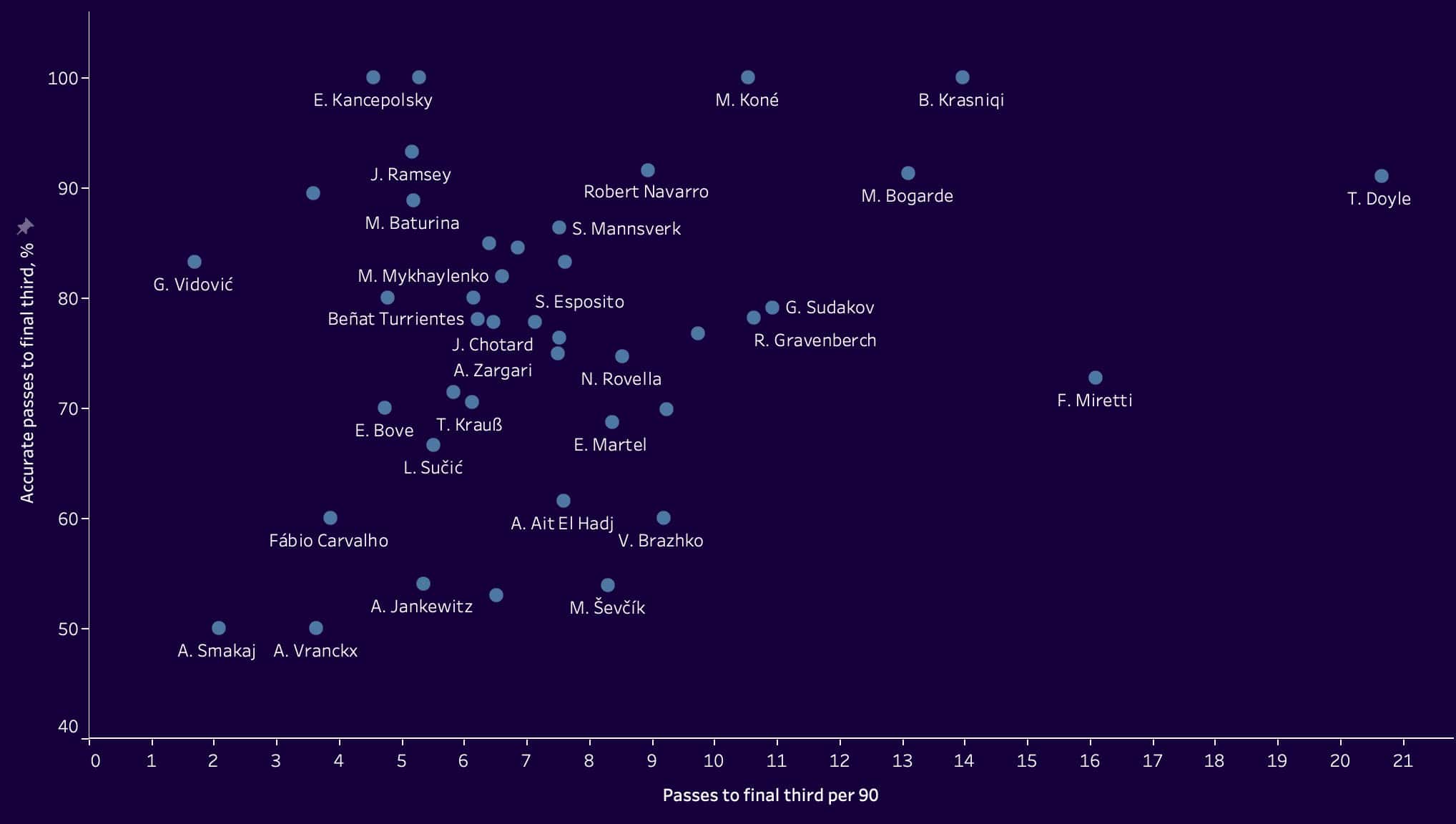
Leading the way in terms of passes into the final third per 90 is Tommy Doyle from England, averaging an impressive 20.66 passes in this crucial area of the pitch. His vision and ability to find teammates in advanced positions proved vital in initiating attacking moves for his team. Fabio Miretti from Italy follows closely with an average of 16.10 passes into the final third, displaying his proficiency in delivering incisive passes to unlock defences. Bledian Krasniqi from Switzerland also demonstrated his impact, averaging 13.97 passes into the final third per 90.
Turning our attention to the success rate of passes into the final third, several midfielders displayed remarkable accuracy in their distribution. Bledian Krasniqi from Switzerland, Manu Koné from France, Nico Gonzalez from Spain, and El Yam Kancepolsky from Israel all achieved a flawless 100% success rate in their passes into the final third. Their precision and ability to find their intended targets with consistency played a crucial role in maintaining possession and creating scoring opportunities.
When considering both the number of successful passes into the final third and the highest success rate, a few standout players demonstrated their impact in this aspect of the game. Bledian Krasniqi from Switzerland, who topped both categories, showcased his ability to influence the game with his accurate and progressive passes. Tommy Doyle from England, known for his excellent passing range, consistently found teammates in dangerous positions. Melayro Bogarde from Belgium also exhibited his ability to make a positive impact in the final third with his passing accuracy.
Key Passing
Key passes and forward passes are two important aspects of football that contribute to a team’s attacking play and goal-scoring opportunities.
Key passes, as defined by Wyscout, refer to passes that lead to a goal-scoring opportunity. These passes are typically played by players in advanced positions and are crucial in unlocking defences and creating clear chances for teammates. Key passes can include through balls, crosses, cut-backs, or any other type of pass that directly sets up a scoring opportunity.
Forward passes, on the other hand, refer to passes played in the direction of the opponent’s goal, aiming to progress the ball towards more advanced areas of the pitch. These passes can be vertical passes that bypass lines of defence or diagonal passes that switch the play and create attacking opportunities. Forward passes are crucial in maintaining attacking momentum, breaking through defensive lines, and creating spaces for teammates to exploit.
The U21 championship will showcase the exceptional talent of central midfielders who excel in the art of key passing, playing crucial passes that unlocked defences and created scoring opportunities. Let’s delve into the top performers in terms of key passing and progressive passing.
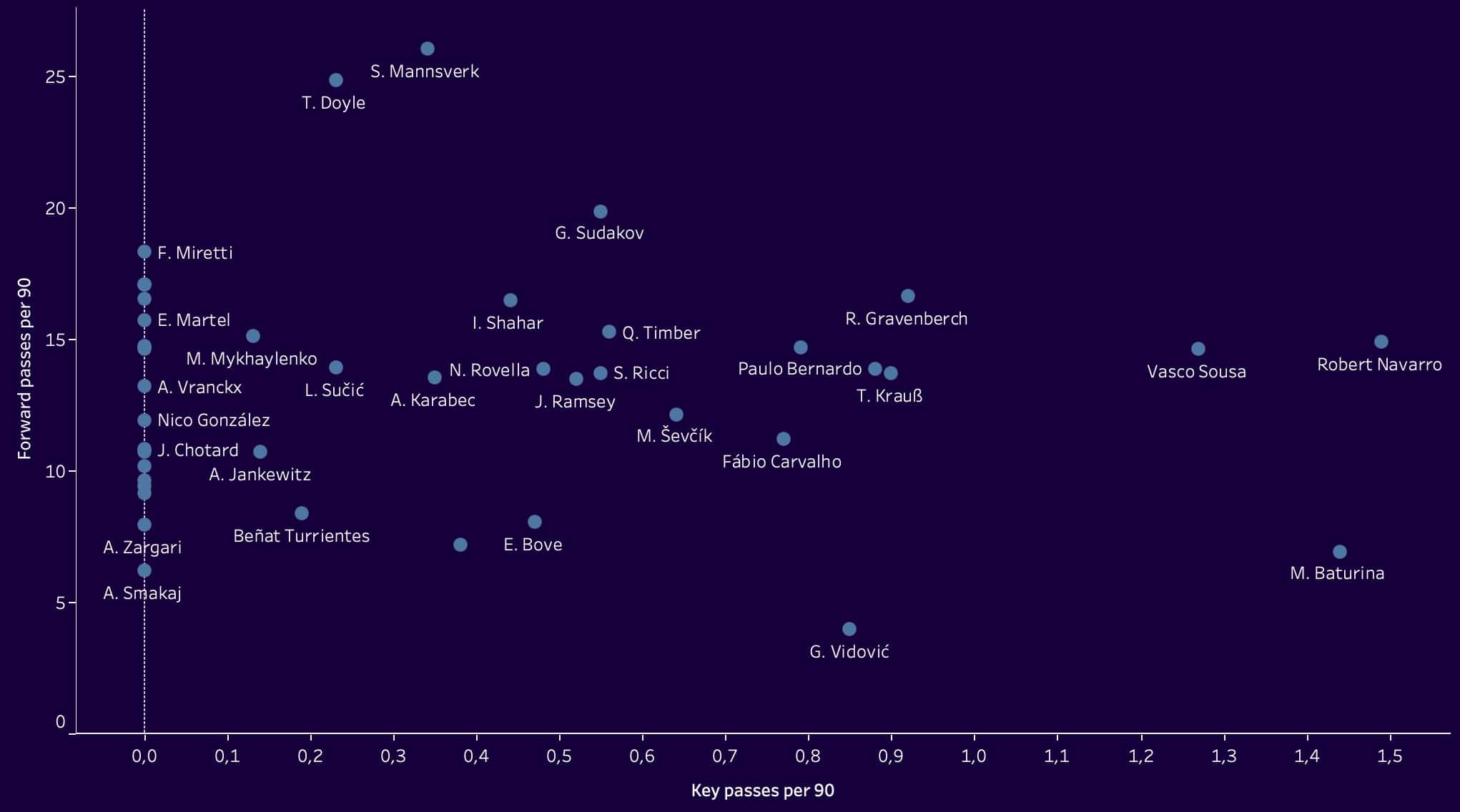
When evaluating key passing statistics, it’s evident that certain midfielders stood out in their ability to deliver impactful passes. Leading the pack in terms of key passes per 90 is Robert Navarro from Spain, averaging an impressive 1.49 key passes. His vision and ability to find teammates in dangerous positions allowed his team to mount threatening attacks. Martin Baturina from Croatia closely follows with an average of 1.44 key passes, showcasing his ability to create opportunities in the final third. Vasco Sousa from Portugal also displayed his playmaking prowess, averaging 1.27 key passes per 90.
Shifting our focus to progressive passing, which involves forward passes that advance the ball and break through defensive lines, several standout midfielders made a significant impact. Sivert Mannsverk from Norway leads the way with an average of 26.01 progressive passes per 90, consistently driving his team forward with a decisive distribution. Tommy Doyle from England closely trails with an average of 24.80 progressive passes, exhibiting his ability to initiate attacks with forward-thinking passing. Georgiy Sudakov from Ukraine also demonstrated his proficiency in progressive passing, averaging 19.84 per 90.
Combining the statistics of key passes and progressive passes, a few central midfielders emerge as influential playmakers during the U21 championship. Ryan Gravenberch from the Netherlands proved his worth with his ability to create key passes while also delivering progressive passes to advance his team’s attacks. Robert Navarro from Spain showcased his playmaking ability by consistently providing both key passes and progressive passes, further enhancing his team’s offensive capabilities. Vasco Sousa from Portugal displayed his well-rounded midfield qualities by contributing with significant key passes and progressive passes.
Attacking Output
Finally, we look at the players who constantly created great opportunities for their teammates by checking out who averaged the most expected assists per 90 minutes. Expected assists work by assigning the xG value of a shot to the player that created that opportunity. Assists on their own can be misleading because a five-yard pass that sets up a 30-yard screamer gets the same amount of credit as a 30-yard pass that sets up a five-yard tap-in.
We also looked at which players average the most expected goals per 90 minutes, to get a sense of who frequently got in good positions to score.
The U21 championship will witness the emergence of dynamic central midfielders who make a significant impact in terms of attacking output, contributing to their team’s goal-scoring potential. Let’s delve into the top performers in terms of expected assists (xA) and expected goals (xG).
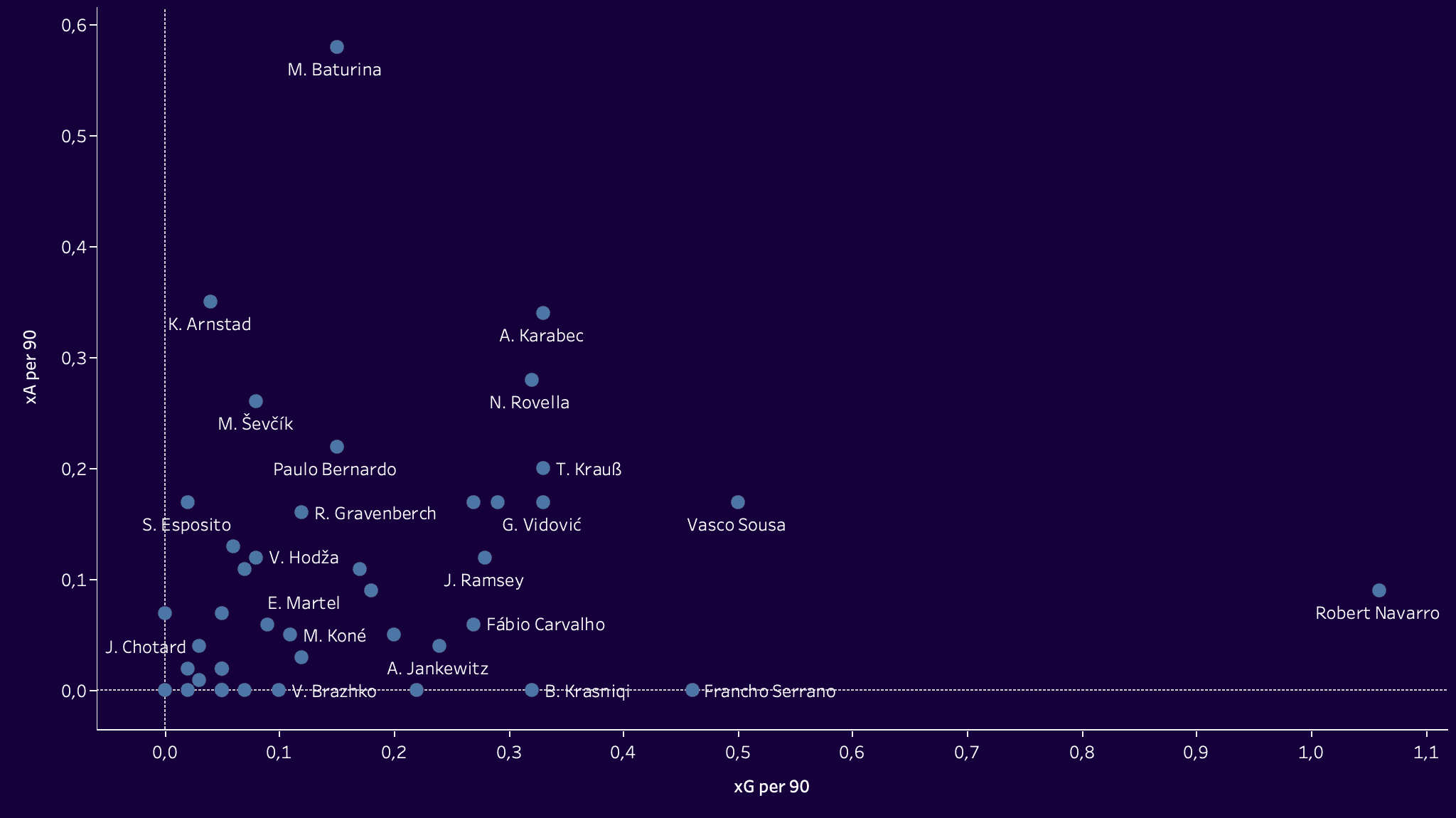
When analyzing the xA per 90 statistics, Martin Baturina from Croatia proved to be the most influential central midfielder, averaging an impressive 0.58 xA. His ability to create scoring opportunities and provide key passes showcased his playmaking prowess. Kristian Arnstad from Norway closely follows with an average of 0.35 xA, displaying his ability to be a creative force in the final third. Adam Karabec from the Czech Republic also exhibited his attacking capabilities, averaging 0.34 xA per 90.
Shifting our focus to xG per 90, which represents the expected goals per match, Robert Navarro from Spain emerged as the top performer in this category, averaging an impressive 1.06 xG. His goalscoring ability from a central midfield position added a significant attacking threat to his team. Vasco Sousa from Portugal also displayed his attacking prowess, averaging 0.5 xG per 90, demonstrating his ability to get into goal-scoring positions. Francho Serrano from Spain showcased his finishing ability from midfield, averaging 0.46 xG per 90.
Combining the statistics of xA and xG, a few central midfielders showcased their ability to contribute significantly to their team’s attacking output. Vasco Sousa from Portugal demonstrated his versatility by leading in both xA and xG, highlighting his ability to create scoring opportunities and finish them himself. Adam Karabec from the Czech Republic showcased his attacking instincts by contributing with high xA and xG figures. Nicolo Rovella from Italy also displayed his attacking impact, further enhancing his team’s goal-scoring potential.
Shortlist
The U21 championship will showcase a pool of talented central midfielders who displayed exceptional creativity and playmaking abilities. Among the standout performers, we have identified a shortlist of players who demonstrated their overall creativity and ability to influence matches.
At the top of the list is Robert Navarro, a 21-year-old midfielder from Spain who represents Real Sociedad. Navarro showcased his exceptional vision and passing range, consistently providing key passes and displaying a keen understanding of the game. His ability to dictate play and create scoring opportunities made him a standout performer in the tournament.
Martin Baturina, a 20-year-old midfielder from Croatia who plays for Dinamo Zagreb, also impressed with his creative contributions. Baturina’s dribbling skills and ability to beat opponents in tight spaces made him a constant threat in the final third. His vision and ability to thread through passes opened up scoring opportunities for his teammates.
Tommy Doyle, a 21-year-old midfielder representing England and currently playing for Sheffield United, displayed his creativity through his exceptional passing range. Doyle’s ability to unlock defences with his precise through balls and key passes made him a crucial player in England’s attacking play.
Vasco Sousa, a 20-year-old midfielder from Portugal who represents FC Porto B, demonstrated his creativity and vision on the field. Sousa’s ability to find pockets of space, provide accurate passes, and create scoring opportunities for his teammates showcased his playmaking abilities.
Lastly, Ryan Gravenberch, a 21-year-old midfielder from the Netherlands who currently plays for FC Bayern, displayed his overall creativity and technical skills. Gravenberch’s combination of dribbling ability, vision, and passing accuracy made him a key figure in the Netherlands’ midfield. His ability to create scoring opportunities and contribute to the attacking phase of the game was instrumental to his team’s success.
Conclusion
The U21 championship is a fascinating tournament, and it certainly is home to plenty of talent. These central midfielders showcased exceptional creativity and playmaking abilities throughout the U21 championship qualification, leaving a lasting impression with their performances. Their vision, passing range, and ability to create scoring opportunities made them standout performers in their respective teams.
The players we profiled in depth all earned their spot in their youth national teams, so it’ll be interesting to see how they perform at the highest level in their respective age group. As they continue to develop and progress in their careers, their overall creativity will undoubtedly make them sought-after assets for their clubs and national teams in future.





Comments